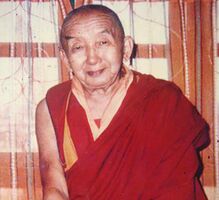Khensur Rinpoche Ngawang Nyima
| MainNamePhon | Khensur Rinpoche Ngawang Nyima |
|---|---|
| namealt | Geshe Ngawang Nyima · Ngawang Nyima |
| YearBirth | 1907/07/18 |
| YearDeath | 1990/11/24 |
| BornIn | Davatai, Buryatia (today's Republic of Buryatia under the Russian Federation) |
| IsInGyatsa | No |
| BnwShortPersonBio | 72nd abbot of Drepung Gomang Monastery, Geshe Ngawang Nyima was born on 18th July, 1907 in Davatai, Buryatia (today's Republic of Buryatia under Russian Federation). His parents, father Tsedup Dorje and mother Tsekyima, were devoted Buddhists. It is said that on the day of his birth, Geshe Lharamba Minyak Lobsang Yonten from Drepung Loseling visited the house of his parents. Later, Lobsang Yonten became the abbot of Loseling College.
Geshe Ngawang Nyima entered the door to Dharma in Shulutuiskii Datsan (Aginskii Datsan) and received vows of Barma Ravjung and novice vows there. Until the age of nine he learnt to read and write in Mongolian and Tibetan languages. Then he memorized various prayers and started to study Buddhist logic. At that time Russia was in the process of Communist revolution and he had to study communist theory at his Monastery. In 1923 he left Buryatia secretly for Tibet and the next year he arrived Lhasa, through Ulaanbaatar. In Lhasa he entered Drepung Gomang Monastic College, and continued his Buddhist studies. Drepung was traditionally the biggest monastery in Tibet and was established in 1416 by Jamyang Choije Tashi Palden, a disciple of Je Tsongkhapa. he lived in Drepung until 1958. Despite many difficulties, such as lack of financial means and not being able to return home to arrange more support due to the political situations, he studied very hard for sixteen years. Often he would have nothing except the clothes he wore and could not even afford offerings to his altar. In 1938 he received the degree of Geshe Rabjim and came to be known among other Geshes for his erudition in classical Buddhist scriptures. He started receiving students to study under his guidance. Geshe Ngawang Nyima received oral transmissions of Kangyur and collected writings of Je Tsongkhapa, his spiritual sons, and many other eminent masters such as the ones from Kangsar Dorjechang. Agwan Nima spent years in meditation, and went on pilgrimage to India for three times. In 1960, at the request of the Dalai Lama of Tibet, he took a teacher's post at Sanskrit University in Varanasi, India. He worked there for seven years. While at Sanskrit University, he wrote in Tibetan a book on Buddhist history, titled "Choijung Lungrig Dronme". He also published a collection of biographies of over two hundred scholars and yogis from India, Tibet and Mongolia. In 1967, again following the request of the fourteenth the Dalai Lama, he went to Laiden, Holland to become a teacher at an Institute. He stayed there for six years writing five volumes on Buddhist philosophy until his retirement from the institute in 1972. Then he traveled to Switzerland where he wrote eight more volumes on Buddhist philosophy. In 1977 he was elected as Abbot of Drepung Gomag Monastic College by the monastic community and in 1978 by the order of the Dalai Lama he became the abbot. He stayed in this position until 1980. At the age of 73 years handed down his position and went to Switzerland for vacasion during which he wrote his autobiography. A year later, he came back to India where many students studied under his guidance. He taught there until the age of 81. In 1990, his health condition became unwell . For three days he was bedridden and then after several days in meditative equipoise of Clear Light, on November 24th, he left this world. (Source Accessed October 21, 2019) |
| Other wikis |
If the page does not yet exist on the remote wiki, you can paste the tag |

